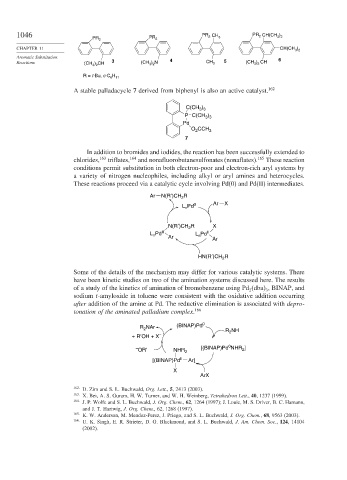Page 1070 - Advanced Organic Chemistry Part B - Reactions & Synthesis
P. 1070
1046 PR 2 CH PR CH(CH )
2
PR PR 2 3 3 2
2
CHAPTER 11 CH(CH )
3 2
Aromatic Substitution 6
Reactions (CH ) CH 3 (CH ) N 4 CH 3 5 (CH ) CH
3 2 3 2 3 2
H
R = t-Bu, c-C 6 11
A stable palladacycle 7 derived from biphenyl is also an active catalyst. 162
)
C(CH 3 3
P C(CH )
3 3
Pd
O CCH 3
2
7
In addition to bromides and iodides, the reaction has been successfully extended to
chlorides, 163 triflates, 164 and nonafluorobutanesulfonates (nonaflates). 165 These reaction
conditions permit substitution in both electron-poor and electron-rich aryl systems by
a variety of nitrogen nucleophiles, including alkyl or aryl amines and heterocycles.
These reactions proceed via a catalytic cycle involving Pd(0) and Pd(II) intermediates.
Ar N(R′)CH 2 R
L Pd 0 Ar X
n
N(R′)CH R X
2
L Pd II Ar L n Pd II Ar
n
HN(R′)CH R
2
Some of the details of the mechanism may differ for various catalytic systems. There
have been kinetic studies on two of the amination systems discussed here. The results
of a study of the kinetics of amination of bromobenzene using Pd (dba) , BINAP, and
2
3
sodium t-amyloxide in toluene were consistent with the oxidative addition occurring
after addition of the amine at Pd. The reductive elimination is associated with depro-
tonation of the aminated palladium complex. 166
R NAr (BINAP)Pd 0 R NH
2
–
+ R′OH + X 2
0
– OR′ NHR 2 [(BINAP)Pd NHR 2 ]
[(BINAP)Pd II Ar]
X
ArX
162
D. Zim and S. L. Buchwald, Org. Lett., 5, 2413 (2003).
163
X. Bei, A. S. Guram, H. W. Turner, and W. H. Weinberg, Tetrahedron Lett., 40, 1237 (1999).
164 J. P. Wolfe and S. L. Buchwald, J. Org. Chem., 62, 1264 (1997); J. Louie, M. S. Driver, B. C. Hamann,
and J. T. Hartwig, J. Org. Chem., 62, 1268 (1997).
165 K. W. Anderson, M. Mendez-Perez, J. Priego, and S. L. Buchwald, J. Org. Chem., 68, 9563 (2003).
166
U. K. Singh, E. R. Strieter, D. G. Blackmond, and S. L. Buchwald, J. Am. Chem. Soc., 124, 14104
(2002).

